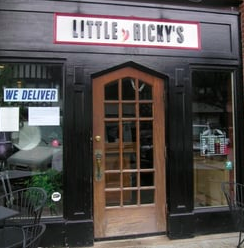This article is the third in a series about creating comprehensible stories. For the first two posts start here.
By delivering compelling comprehensible input to our students, we allow them to understand messages in the target language so effortlessly that they ignore the ‘delivery truck,’ or language of instruction. (Thanks to Ben Slavic for the metaphor!) They are so focused on the meaning of the story, the picture, the artifact, the conversation, or the drama, that it’s delivery language recedes to the background.
In this post, I describe how my ongoing story about Guácala, the sushi-loving T-Rex, takes on deeper meaning, and allows for more contextualized and compelling repetition of the message, through student dramatization.
 Recall how I had the puppet visit two local eateries before ending up at the ubiquitous Costco, where he found the object of his gastronomical affections.
Recall how I had the puppet visit two local eateries before ending up at the ubiquitous Costco, where he found the object of his gastronomical affections.
A novel twist that allows my young charges to see the dramatic action while I narrate it in real time involves student actors, who move about the drama- conducive classroom for the ‘audience’ to enjoy. In such a space, I’ve jettisoned all desks and tables (haven’t had any for 5 years) to carve out acting zones. (On the rare occasion where writing/drawing surfaces are required, we use clipboards at our seats.)
 Before my first graders arrived, I posted an 8.5″ x 11″ poster of each of my three locales – the two local restaurants, and Costco – whose iconic photos I found on Google Images – in three distinct areas of my classroom.
Before my first graders arrived, I posted an 8.5″ x 11″ poster of each of my three locales – the two local restaurants, and Costco – whose iconic photos I found on Google Images – in three distinct areas of my classroom.
Next I asked, as I peered into the group, “Where is Guácala the dinosaur? We need a dinosaur actor!” I enlisted help while flourishing an irresistible Dollar $tore dino hat. To involve a few more kids, I ‘hired’ one to ‘work’ at Costco, plus the two other restaurants; four actors in total.
I trained my actors on the spot, insisting that they do exactly and only as I say. (I often brandish my sparkly sunglasses and golden Emmy during this actor training time.)
First, Guácala stood near the Little Ricky’s (LR) restaurant poster, with a kid in a waiter’s apron next to him. As I recounted the story, I moved dino’s hand to rub his tummy when he was hungry; modeled when and how to stomp in frustration when the waiter said ‘no’ to the question, “Does LR have sushi?” and where to run fast (or walk slowly), when it was time to try another location. The kids were captivated and time stood still! We were in a state of FLOW* – where language disappeared, and all that mattered was the hungry dinosaur’s quest for sushi.
Next our audience shifted its gaze to the opposite wall, where our hero ascertained from a chef at Marco Roma pizzeria that sushi wasn’t available there either – with a scene like the one at LR. Finally, the children turned again toward Costco – which, like a shining castle on a hill, sold sushi by the commercial roll-top refrigerator case-full.
The episode ends with a dramatic “EL FIN” (i.e., ‘The End’) followed by hearty applause for the actors, and enthusiastic appeals to “Do it again!” with a different batch of volunteer actors.
Note that the student actors need not talk or recite lines while ‘onstage-‘ my narrating while they act stimulates the listeners’ language acquisition, as the words and actions match up in their unconscious minds.
What was my language teacher role in this playful escapade? To insure that my young students effortlessly understood the story language (i.e., all the teaching leading up to the dramatization); to manage the classroom by laying in and lovingly holding my students responsible for appropriate behavior. Oh, and printing/posting posters of 3 locations.
What a delightful way to spend the afternoon! As the school week draws to a close, my first graders will spend the last class segment acting and re-enacting the Dino Loves Sushi skit again and again!
Like sushi itself – try it, you’ll love it and you’ll want more!


 Finally, Guácala goes (drives his minivan?) to Costco (where all roads lead.) The kids love the very mention of Costco, and glaze over with memories of bite-size samples.
Finally, Guácala goes (drives his minivan?) to Costco (where all roads lead.) The kids love the very mention of Costco, and glaze over with memories of bite-size samples.